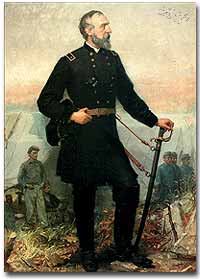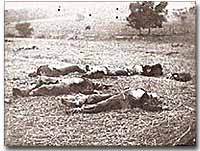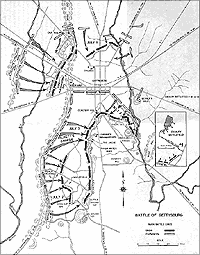33g. Gettysburg: High Watermark of the Confederacy

Robert E. Lee had a vision.
He proposed to take the offensive, invade Pennsylvania, and defeat the Union Army in its own territory. Such a victory would relieve Virginia of the burden of war, strengthen the hand of Peace Democrats in the North, and undermine Lincoln's chances for reelection. It would reopen the possibility for European support that was closed at Antietam. And perhaps, it would even lead to peace.
The result of this vision was the largest battle ever fought on the North American continent. This was Gettysburg, where more than 170,000 fought and over 40,000 were casualties.
Lee began his quest in mid-June 1863, leading 75,000 soldiers out of Virginia into south-central Pennsylvania. Forty miles to the south of Lee, the new commander of the Union Army of the Potomac, General George Meade, headed north with his 95,000 soldiers. When Lee learned of the approach of this concentrated force, he sent couriers to his generals with orders to reunite near Gettysburg to do battle. As sections of the Confederate Army moved to join together, CSA General A.P. Hill, heard a rumor that that there was a large supply of shoes at Gettysburg. On July 1, 1863, he sent one of his divisions to get those shoes. The battle of Gettysburg was about to begin.

The carnage at the Battle of Gettysburg was brutal. After the battle, casualties from both sides littered the battlefield as survivors picked over the bodies for supplies, clothes, and shoes.
As Hill approached Gettysburg from the west, he was met by the Union cavalry of John Buford. Couriers from both sides were sent out for reinforcements. By early afternoon, 40,000 troops were on the battlefield, aligned in a semicircle north and west of the town. The Confederates drove the outnumbered Union troops to Cemetery Hill, just south of town, where Union artillery located on the hill halted the retreat.
At noon on July 2, the second day of the battle, Lee ordered his divisions to attack, hoping to crumble both sides of the Union line and win the battle. The Big Round Top and Little Round Top were nearby hills that had been left unprotected. If the Confederates could take these positions, they could surround the Union forces.

This map of Gettysburg shows Union troop movements in black and Confederate troop movements in white over the three days of the battle.
Union troops under Colonel Joshua Chamberlain arrived just in time to meet Confederate troops charging up the hill to Little Round Top. In some of the most ferocious fighting of the battle, Chamberlain's 20th Maine held on to Little Round Top and perhaps saved the Union from defeat.
Lee was determined to leave Pennsylvania with a victory. On the third day of battle, he ordered a major assault against the center of the Union line on Cemetery Ridge. Confederate batteries started to fire into the Union center. The firing continued for two hours. At 3 p.m., 14,000 Confederate soldiers under the command of General George Pickett began their famous charge across three-quarters of a mile of open field to the Union line.
Few Confederates made it. Lee's attempt for a decisive victory in Pennsylvania had failed. He had lost 28,000 troops — one-third of his army. A month later, he offered his resignation to Jefferson Davis, which was refused. Meade had lost 23,000 soldiers.
The hope for Southern recognition by any foreign government was dashed. The war continued for two more years, but Gettysburg marked the end of Lee's major offensives. The Confederacy tottered toward its defeat.




